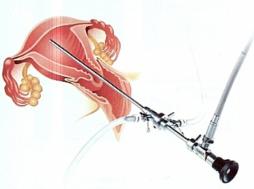Hysteroscopy
A hysteroscopy is an examination in which the gynecologist looks inside the uterus with a viewing tube. Through a thin tube (hysteroscope) inserted into the vulva, the gynecologist looks at the inside of your uterus.

Some reasons for a hysteroscopy are:
- Abnormal blood loss during or between periods
- Postmenopausal blood loss
- Abnormal findings at ultrasound scan
- The presence of a polyp or myoma (fibroid) in the uterus
- When the threads of the coil are no longer visible
- Reduced fertility and repeated preterm births or miscarriages
- Failure to have a period after curettage
- Suspicion of a remainder after miscarriage or pregnancy
- Viewing a niche
- After a previous surgical procedure on the uterus
The diagnostic hysteroscopy
Preparation
Together with you, we will plan an appointment. We advise you to take 1000 mg paracetamol and/or 400 mg ibuprofen 1 hour before this appointment, provided that you are not allergic to them. You do not need to be fasting for this examination.
The examination preferably takes place when you are not menstruating. Sometimes abnormal bleeding is the reason for this examination, and then blood loss is often unavoidable and not a problem. If you are on the pill, the examination can take place on all days you are on the pill.
The course of the examination
You will be seated on a gynecological chair with your lower body undressed. In principle, this procedure does not require anesthesia. In principle, the procedure will take place without the use of a speculum. The gynecologist inserts the hysteroscope into the vagina, which then fills with warm water. You will also feel this water drain back out of the vagina; you will lie on an absorbent mat. While the gynecologist is watching the monitor, he/she will look for the opening of the cervix, and it will be passed with the hysteroscope. This may cause a (brief) uncomfortable sensation. Sometimes it is necessary to stretch the cervix slightly. Your cervix is then anesthetized, with a thin needle, in one spot. The uterine cavity then fills with warm water. In this way, it is possible to inspect the uterine cavity. It is then also possible to take a biopsy, remove a polyp or remove a coil. You can follow the entire examination on the monitor. The examination lasts about fifteen minutes. The gynecologist will discuss the results with you immediately.
Aftercare
Afterward, you will have the opportunity to recover for a while. Only when you feel completely well again can you go home. Sometimes a patient may need a little more time to recover. Please note that you may not drive a car yourself, so it is important that someone comes with you or picks you up. Two to three hours after the procedure, you may take another painkiller. If this is not sufficient, you should take paracetamol 500 mg, spread over the day, up to a maximum of 8 tablets per day. In the first days after surgery, you may experience slight vaginal bleeding and some abdominal pain. We recommend that you take it easy for the first few hours after the procedure.
When to contact
If unexpected events such as fever (temperature , a lot of pain, not responding to painkillers, sudden heavy blood loss, or inability to urinate correctly, please get in touch with us immediately.
